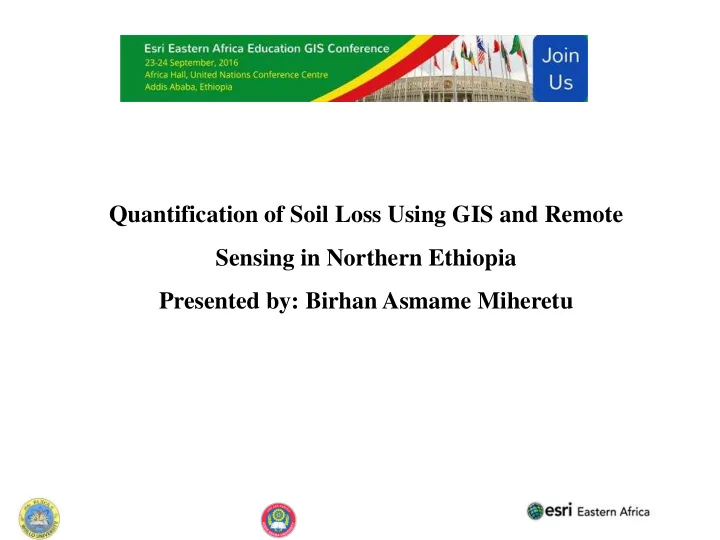

Quantification of Soil Loss Using GIS and Remote Sensing in Northern Ethiopia Presented by: Birhan Asmame Miheretu
Outline of Presentation Introduction Objective Materials and methods Result and discussion Conclusion and recommendation
Introduction Soil erosion is a major environmental threat. Annually, Ethiopia losses over 1.5 billion tons of topsoil which could have added about 1.5 million tons of grain to the country’s harvest . The immediate consequence lowering crop yields, leading to higher poverty rates.
Cont… The high rates of soil erosion in Ethiopia is mainly caused by: deforestation overgrazing, detrimental cultivation practices poverty, land fragmentation and expansion of cropland on steep slopes and unsustainable use of natural resources
Cont… Spatial and quantitative information on soil erosion loss on a sub watershed scale is therefore contributes significantly to plan and prioritizes treatments of the sub watershed. Against Other models, the Revised Universal Soil Loss Equation (RUSLE) has been the most widely used model in predicting soil erosion loss because of its simplicity, limited data requirement and compatibility with GIS.
Objective to assess soil erosion rate or hazard at Gelana sub watershed, Northern Highlands of Ethiopia based on the integration of remote sensing and GIS techniques using RUSLE model.
Materials and methods The Gelana sub-watershed is situated in Wollo area, Amhara region of Ethiopia. Geographically, it lies between 11 o 34 ’ 44 ” and 11 o 45 ’ 4 ”N, and 39 o 34 ’ 11 ” and 39 o 45 ’ 2 ”E .
Methodology and parameter estimation The RUSLE method is expressed as: A=R*K*LS*C*P (1) Rainfall erosivity (R) factor: determination of the rainfall erosivity factor was done using a formula that was modified and adapted to Ethiopian condition by Hurni (1985). R= -8.12 + 0.562P (2) Soil erodibility (K) factor: The soil map of the study area was reclassified to K factor values following the approach adapted to the soil of the highlands Ethiopia (Table 1) by Hurni (1985) and Hellden (1987).
Cont… Table 1. Soil class of the study area and their respective erodibility factor values Soil class Soil color Soil erodibility (K) factor value Vertisols Black 0.15 Regosols Brown 0.20 Cambisols Brown 0.20 Leptosols Brown 0.20 Gleysols Black 0.15 Slope length and steepness factor (LS): Derived from DEM of ASTER image ( http://earthexplorer.usgs.gov/). LS = (Flow Accumulation x Cell Size/22.13) 0.4 x (sin slope/0.0896) 1.3
Cont… Land use/ cover-management (C) factor: was derived from Landsat 8 of 2014. Table 2. Land use/ cover (C) factor values Land use /cover type C factor Sources Forest 0.01 Hurni,1985 Shrub land 0.01 Asmamaw et al., 2012 Cultivated land (teff) 0.25 Hurni,1985 Grass land 0.01 Hurni,1985 Bare land 0.05 Asmamaw et al., 2012 Urban built up area 0.05 Asmamaw et al., 2012 Wetland 0.01 Bewket & Teferi, 2009
Cont… Conservation practice (P) factor: was adopted from Wischmeier & Smith (1978), which considers two types of land uses (agricultural land and other land use) and land slopes. Table 3. P values (Wischmeier & Smith, 1978) Land use type Slope (%) P factor value 0-5 0.1 Agricultural land 5-10 0.12 10-20 0.14 20-30 0.19 30-50 0.25 50-100 0.33 Other land All 1
Result and discussion Figure 2. Soil erosion hazard and hotspots in Gelana sub watershed, Northern highlands of Ethiopia
Cont.. The soil loss ranges from 0 to over 125 t h -1 y -1 The mean soil loss rate was 24.3 t h -1 y -1 . Bewket & Teferi (2009), estimated 93 t ha _1 y _1 Chemoga and Hurni (1993), estimated 42 t ha -1 yr -1 from cultivated fields for Ethiopia Therefore, the current rate in the study area was the lowest. This might be due to the contribution of area closure and different conservation measures implemented in the study area .
Cont… About 22% of the total area was classified under high, very high , severe, and very severe soil loss erosion classes. However, the total annual soil loss from these classes accounts for about 84% of the entire Gelana sub watershed. Accordingly, areas of high, very high , severe, and very severe are the critical areas that require urgent soil and water conservation measures.
Conclusion and Recommendation The study showed that the application of RUSLE facilitates Cont… sustainable land use planning. The result indicated that the mean soil loss rate was lower than the results of the past findings in different parts of Ethiopia. However, the present value indicates that there is still a need to do more for designing appropriate land management measures that slowdown the amount of soil loss in the study area. Therefore, about 22 % of the total of the sub watershed were prone to high erosion severity and needed a high priority for the implementation of soil control measures .
Recommend
More recommend